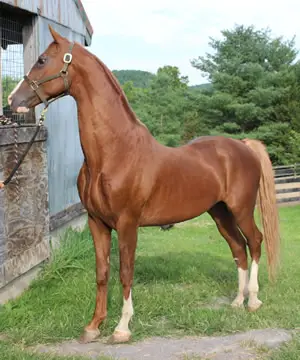History
The American Saddlebred horse can trace its roots to the easy gaited Galloway and Hobbie horses which were shipped to North America from the British Isles in the 1600s. These hardy little horses thrived and grew in the new environment; through selective breeding the Narragansett Pacer was developed and named for Rhode Island's Narragansett Bay area where many were raised. These were also found up and down the eastern seaboard, including Virginia where they were also produced in large numbers. These animals moved their legs in concert on the same side of their bodies, contacting the ground in a broken cadence. The ride was comfortable, compared to the jolt of a trot. These horses are now "extinct" in the U. S. and in mane, because they were exported to the West Indies by the thousands. The Paso Fino is a direct descendant of the Narragansett and is probably almost the same horse.
Before they were all gone, Narragansett mares were crossed with Thoroughbreds, which the colonists began importing from England in the early 1700s. By 1776 during the American Revolution, a horse simply called the American horse had become a recognized type. It had the size and beauty of the Thoroughbred, but retained the ability to learn the easy riding gaits. These animals were used for riding, to pull the plow during the week, the carriage on Saturday night and for other work. They were prized for a pleasant temperament, eagerness, strength and stamina.
It was the American horse that carried colonial cavalry to victory over the British at King's Mountain in South Carolina. After the Revolution, they carried their masters through the Cumberland Gap to the frontier of Kentucky. These animals were the immediate precursors of the American Saddlebred.
There was continual crossing with Thoroughbreds, and over time some Morgan and Standardbred blood was added. When the first horse shows were held in Kentucky, Virginia and Missouri in the early 1800s, Saddlebreds were frequently judged the winners because of their beauty, style and utility. The first "national" horse show was held in 1856 at the St. Louis Fair and Saddlebreds were prominent.
Horses became a major commercial commodity in Kentucky, and "Kentucky saddlers" were particularly prized and achieved national prominence. Thousands were shipped to the eastern market and throughout the south. This is the first breed of horse claimed by the Commonwealth of Kentucky as its own.
By the time of the Civil War, Saddlebreds were among the most popular riding animals in America. They were used in great numbers by the Confederate cavalry and demonstrated incredible endurance and dependability on long marches and under fire. The men of John Hunt Morgan and Nathan Bedford Forest were exclusively mounted on these horses. Generals on both sides proudly rode Saddlebreds. Traveller, General Robert E. Lee's mount and the most famous horse of the war had breeding typical of an early Saddlebred. His sire was the Thoroughbred Gray Eagle and his dam a mare of mixed breeding. Traveller possessed a smooth rack.
After this terrible strife, American Saddlebred horses went to all parts of the nation with returning soldiers. They could be seen on the bridle paths of Central Park in New York City and on the plains of Texas herding cattle. Today, Saddlebreds are found in all 50 states, Canada, England, Germany, Holland, Scandinavia, Italy, Greece, Australia, Japan and many other countries. The Saddlebred is the most popular of the non-racing breeds in South Africa, which began importing them after World War I. A five gaited stallion bred and raised in South Africa won the World's Grand Championship at the 1997 Kentucky State Fair.
Behavior
Its conformation enables the breed to perform well in all equine events especially dressage, jumping, carriage and endurance. A distinguishable trait is high intelligence. Alert and curious, Saddlebreds possess personality, making them people-oriented." Saddlebred come in all colors, as there have never been color restrictions.
Function
Outside of breed-specific shows, the Saddlebred is also promoted as suitable for competitive trail riding, endurance riding, dressage, combined driving, eventing, and show jumping. Some Saddlebreds are also suitable for fox hunting, cutting and roping. Because they are so closely affiliated with their traditional show ring competition, they are sometimes mistaken for warmbloods or Thoroughbred crosses when participating in other equine events. They are also suitable family horses used for trail and pleasure riding and ranch work.






